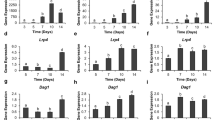Abstract
Matrix extracellular phosphoglycoprotein (Mepe) is a bone metabolism regulator that is expressed by osteocytes in normal adult bone. Here, we used an immunohistochemical approach to study whether Mepe has a role in murine long bone development and regeneration. Our data showed that Mepe protein was produced by osteoblasts and osteocytes during skeletogenesis, as early as 2 days postnatal. During the healing of non-stabilized tibial fractures, which occurs through endochondral ossification, Mepe expression was first detected in fibroblast-like cells within the callus by 6 days postfracture. By 10 and 14 days postfracture (the hard callus phase of repair), Mepe was expressed within late hypertrophic chondrocytes and osteocytes in the regenerating tissues. Mepe became externalized in osteocyte lacunae during this period. By 28 days postfracture (the remodeling phase of repair), Mepe continued to be robustly expressed in osteocytes of the regenerating bone. We compared the Mepe expression profile with that of alkaline phosphatase, a marker of bone mineralization. We found that both Mepe and alkaline phosphatase increased during the hard callus phase of repair. In the remodeling phase of repair, Mepe expression levels remained high while alkaline phosphatase activity decreased. We also examined Mepe expression during cortical bone defect healing, which occurs through intramembranous ossification. Mepe immunostaining was found within fibroblast-like cells, osteoblasts, and osteocytes in the regenerating bone, through 5 to 21 days postsurgery. Thus, Mepe appears to play a role in both long bone regeneration and the latter stages of skeletogenesis.



Similar content being viewed by others
References
Albrecht UEG, Helms JA, Lin H (1997) Visualization of gene expression patterns by in situ hybridization. In: Daston GP (ed) Molecular and cellular methods in developmental toxicology. CRC Press, Boca Raton, pp 23–48
Argiro L, Desbarats M, Glorieux FH, Ecarot B (2001) Mepe, the gene encoding a tumor-secreted protein in oncogenic hypophosphatemic osteomalacia, is expressed in bone. Genomics 74:342–351
Boden SD, Kaplan FS (1990) Calcium homeostasis. Orthop Clin North Am 21:31–42
Bonnarens F, Einhorn TA (1984) Production of a standard closed fracture in laboratory animal bone. J Orthop Res 2:97–101
Colnot C, Thompson Z, Miclau T, Werb Z, Helms JA (2003) Altered fracture repair in the absence of MMP9. Development 130:4123–4133
Doppelt SH (1984) Vitamin D, rickets, and osteomalacia. Orthop Clin North Am 15:671–686
Gowen LC, Petersen DN, Mansolf AL, Qi H, Stock JL, Tkalcevic GT, Simmons HA, Crawford DT, Chidsey-Frink KL, Ke HZ, et al (2003) Targeted disruption of the osteoblast/osteocyte factor 45 gene (OF45) results in increased bone formation and bone mass. J Biol Chem 278:1998–2007
Guo R, Rowe PS, Liu S, Simpson LG, Xiao ZS, Darryl Quarles LD (2002) Inhibition of Mepe cleavage by Phex. Biochem Biophys Res Commun 297:38–45
Igarashi M, Kamiya N, Ito K, Takagi M (2002) In situ localization and in vitro expression of osteoblast/osteocyte factor 45 mRNA during bone cell differentiation. Histochem J 34:255–263
Le AX, Miclau T, Hu D, Helms JA (2001) Molecular aspects of healing in stabilized and non-stabilized fractures. J Orthop Res 19:78–84
Lieberman JR, Daluiski A, Einhorn TA (2002) The role of growth factors in the repair of bone. Biology and clinical applications. J Bone Joint Surg Am 84-A:1032–1044
MacDougall M, Simmons D, Gu TT, Dong J (2002) Mepe/OF45, a new dentin/bone matrix protein and candidate gene for dentin diseases mapping to chromosome 4q21. Connect Tissue Res 43:320–330
Nelson AE, Robinson BG, Mason RS (1997) Oncogenic osteomalacia: is there a new phosphate regulating hormone? Clin Endocrinol (Oxf) 47:635–642
Petersen DN, Tkalcevic GT, Mansolf AL, Rivera-Gonzalez R, Brown TA (2000) Identification of osteoblast/osteocyte factor 45 (OF45), a bone-specific cDNA encoding an RGD-containing protein that is highly expressed in osteoblasts and osteocytes. J Biol Chem 275:36172–36180
Quarles LD (2003) FGF23, PHEX, and Mepe regulation of phosphate homeostasis and skeletal mineralization. Am J Physiol Endocrinol Metab 285:E1–E9
Rowe PS, de Zoysa PA, Dong R, Wang HR, White KE, Econs MJ, Oudet CL (2000) Mepe, a new gene expressed in bone marrow and tumors causing osteomalacia. Genomics 67:54–68
Sandhu HS, Khan SN (2003) Recombinant human bone morphogenetic protein-2: use in spinal fusion applications. J Bone Joint Surg Am 85-A Suppl 3:89–95
Tam CS, Heersche JN, Jones G, Murray TM, Rasmussen H (1986) The effect of vitamin D on bone in vivo. Endocrinology 118:2217–2224
Thompson Z, Miclau T, Hu D, Helms JA (2002) A model for intramembranous ossification during fracture healing. J Orthop Res 20:1091–1098
Valentin-Opran A, Wozney J, Csimma C, Lilly L, Riedel GE (2002) Clinical evaluation of recombinant human bone morphogenetic protein-2. Clin Orthop 110–120
Wallach S, Rousseau G, Martin L, Azria M (1999) Effects of calcitonin on animal and in vitro models of skeletal metabolism. Bone 25:509–516
Acknowledgements
The authors would like to thank D. Hu for expert technical assistance, Acologix for providing the primary Mepe antibody, and S.S. Sidhu for helpful comments on the manuscript. This work was supported by funds from R01 DE31497 and P60 DE13058 (J.A.H.), K08 AR02164 (T.M.), and R01 AR46238 (Z. Werb).
Author information
Authors and Affiliations
Corresponding author
Rights and permissions
About this article
Cite this article
Lu, C., Huang, S., Miclau, T. et al. Mepe is expressed during skeletal development and regeneration. Histochem Cell Biol 121, 493–499 (2004). https://doi.org/10.1007/s00418-004-0653-5
Accepted:
Published:
Issue Date:
DOI: https://doi.org/10.1007/s00418-004-0653-5



